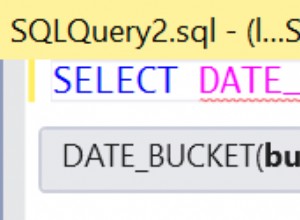Takie problemy są łatwiejsze do rozwiązania, jeśli masz tabelę kalendarza ze wszystkimi potrzebnymi datami. Jeśli nie masz takiej tabeli, możesz ją utworzyć za pomocą zapytania takiego:
create table `calendar` (
`date` DATE NOT NULL,
PRIMARY KEY (`date`)
)
select DATE_ADD('1900-01-01',INTERVAL t4.c*10000 + t3.c*1000 + t2.c*100 + t1.c*10 + t0.c DAY) as `date`
from
(select 0 c union all select 1 union all select 2 union all select 3 union all select 4 union all select 5 union all select 6 union all select 7 union all select 8 union all select 9) t0,
(select 0 c union all select 1 union all select 2 union all select 3 union all select 4 union all select 5 union all select 6 union all select 7 union all select 8 union all select 9) t1,
(select 0 c union all select 1 union all select 2 union all select 3 union all select 4 union all select 5 union all select 6 union all select 7 union all select 8 union all select 9) t2,
(select 0 c union all select 1 union all select 2 union all select 3 union all select 4 union all select 5 union all select 6 union all select 7 union all select 8 union all select 9) t3,
(select 0 c union all select 1 union all select 2 union all select 3 union all select 4 union all select 5 union all select 6 union all select 7 union all select 8 union all select 9) t4
Spowoduje to utworzenie tabeli z datami od 1900-01-01 do 2173-10-15 (100K dni) i zużyje tylko około 2,5 MB. Możesz dostosować go do swoich potrzeb.
Korzystając z tabeli kalendarzowej, możesz uzyskać trzymiesięczne przedziały:
select
DATE_FORMAT(date_sub(c.date, INTERVAL 1 day), '%Y-%m') as month,
date_sub(c.date, INTERVAL 3 month) as first_day,
date_sub(c.date, INTERVAL 1 day) as last_day
from calendar c
where day(c.date) = 1
and c.date between '2015-02-01' and '2015-09-01'
Wynik:
| month | first_day | last_day |
| 2015-01 | 2014-11-01 | 2015-01-31 |
| 2015-02 | 2014-12-01 | 2015-02-28 |
| 2015-03 | 2015-01-01 | 2015-03-31 |
| 2015-04 | 2015-02-01 | 2015-04-30 |
| 2015-05 | 2015-03-01 | 2015-05-31 |
| 2015-06 | 2015-04-01 | 2015-06-30 |
| 2015-07 | 2015-05-01 | 2015-07-31 |
| 2015-08 | 2015-06-01 | 2015-08-31 |
Dostosuj to, jeśli naprawdę chcesz użyć około 90-dniowych odstępów.
Teraz wystarczy proste lewe sprzężenie z tabelą logowania, aby uzyskać to, czego chcesz:
select i.month as `Date`, count(distinct l.user_id) as `Active users`
from (
select
date_format(date_sub(c.date, interval 1 day), '%Y-%m') as month,
date_sub(c.date, interval 3 month) as first_day,
date_sub(c.date, interval 1 day) as last_day
from calendar c
where day(c.date) = 1
and c.date between '2015-02-01' and '2015-09-01'
) i
left join login_table l on l.login_date between i.first_day and i.last_day
group by i.month
http://sqlfiddle.com/#!9/d1bb0/3




